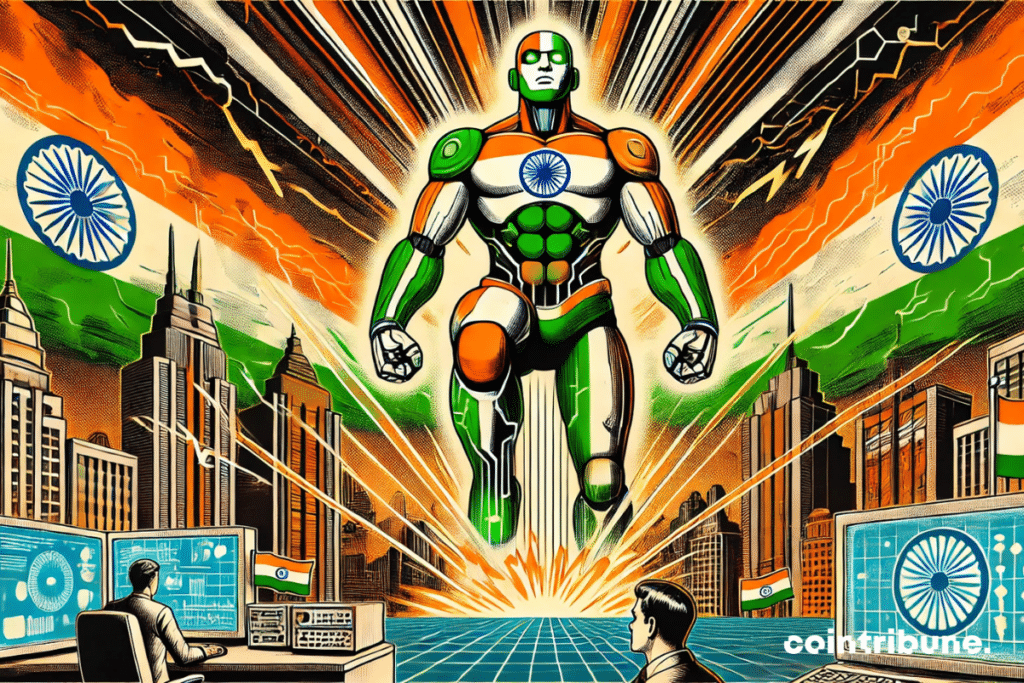India’s AI Push : Competing With The US And China On Innovation
Artificial intelligence has become a major strategic issue. From the United States to China, through Europe, economic powers are competing to dominate this key sector. Far from remaining on the sidelines, India has just announced the development of its own generative AI model, scheduled for 2025. With a massive acquisition of graphics processors and an investment plan of $20 billion in infrastructure, the country shows a clear ambition: to strengthen its digital sovereignty and assert its technological independence. This initiative comes as technological tensions between Washington and Beijing are escalating and as American restrictions on Nvidia chips complicate access to cutting-edge technologies. At the same time, the emergence of open-source models like DeepSeek R1 is disrupting the rules of the game, proving that it is possible to develop high-performance AI without having the same resources as industry giants.

India strengthens its game to become an AI player
India no longer wants to depend on foreign technologies. Indeed, the government now expresses its ambition to become a key player in artificial intelligence with the launch of its own generative AI model. During the Utkarsh Odisha Conclave from the 28th to the 29th in Bhubaneswar, IT Minister Ashwini Vaishnaw confirmed this strategy and specified that the model in development would be specifically designed to adapt to the many languages and cultures of the country. “We believe that at least six major developers will be able to design models within a period of six to eight months, or even four to six months in a more optimistic estimate,” he stated.
To support this project, New Delhi has already secured top-notch hardware infrastructure. The country has acquired 18,693 GPUs, including 12,896 Nvidia H100 chips, essential for training large-scale AI models. Meanwhile, $20 billion in foreign investments will be injected into the development of data centers over the next three years. These efforts aim to create a robust and independent digital ecosystem capable of supporting the rise of AI in India and accelerating local innovation. Ultimately, the goal is twofold: to reduce dependence on Western technologies and to strengthen the country’s digital sovereignty in the face of increasingly intense global competition.
An initiative set against a backdrop of technological tensions
While the Indian generative AI project primarily addresses national issues, it integrates into an international context marked by rising tensions and strategic mutations. The recent emergence of the DeepSeek R1 model has shaken the certainties surrounding the domination of industry giants. This open-source tool, as powerful as those developed by OpenAI, was trained with far fewer resources, which proves that the race for AI is no longer exclusively reserved for the most powerful players. For India, this advancement opens new perspectives and reinforces the idea that an emerging country can accelerate its development by relying on more accessible technological solutions.
At the same time, American restrictions on the export of Nvidia AI chips further complicate the global balance. Washington has banned the sale of H100 chips to China and limited access to modified versions like the A800 and H800, thus hindering the growth of its Asian competitors. Officially, these sanctions aim to preserve the technological lead of the United States. However, they could also stimulate the development of independent alternatives, particularly in India, where the government relies on its own infrastructure to circumvent this dependence on American suppliers.
In response to these restrictions, the United States has launched Project Stargate, a $500 billion program led by OpenAI, Oracle, and SoftBank. This initiative aims to maintain American supremacy in the AI sector by creating an even more efficient and difficult-to-compete ecosystem. In this context of the race for innovation, India must prove that its generative AI model is not limited to a national ambition but can truly enable it to establish itself as a key player in the global technological revolution.
India is at a decisive turning point. With massive investments in its infrastructure and a strategy focused on technological independence, it aspires to become a major player in artificial intelligence. Thus, the slowdown of certain competitors, particularly Chinese ones, could provide it with a unique opportunity to accelerate its development and establish itself as a global AI hub. However, many challenges remain: competition with established giants, the need to attract talent, and the development of infrastructure capable of supporting sovereign AI. If successful, India could redefine the global technological power balance and prove that innovation no longer relies solely on the traditional centers of Silicon Valley and Beijing.
Maximize your Cointribune experience with our "Read to Earn" program! For every article you read, earn points and access exclusive rewards. Sign up now and start earning benefits.
Diplômé de Sciences Po Toulouse et titulaire d'une certification consultant blockchain délivrée par Alyra, j'ai rejoint l'aventure Cointribune en 2019. Convaincu du potentiel de la blockchain pour transformer de nombreux secteurs de l'économie, j'ai pris l'engagement de sensibiliser et d'informer le grand public sur cet écosystème en constante évolution. Mon objectif est de permettre à chacun de mieux comprendre la blockchain et de saisir les opportunités qu'elle offre. Je m'efforce chaque jour de fournir une analyse objective de l'actualité, de décrypter les tendances du marché, de relayer les dernières innovations technologiques et de mettre en perspective les enjeux économiques et sociétaux de cette révolution en marche.
The views, thoughts, and opinions expressed in this article belong solely to the author, and should not be taken as investment advice. Do your own research before taking any investment decisions.